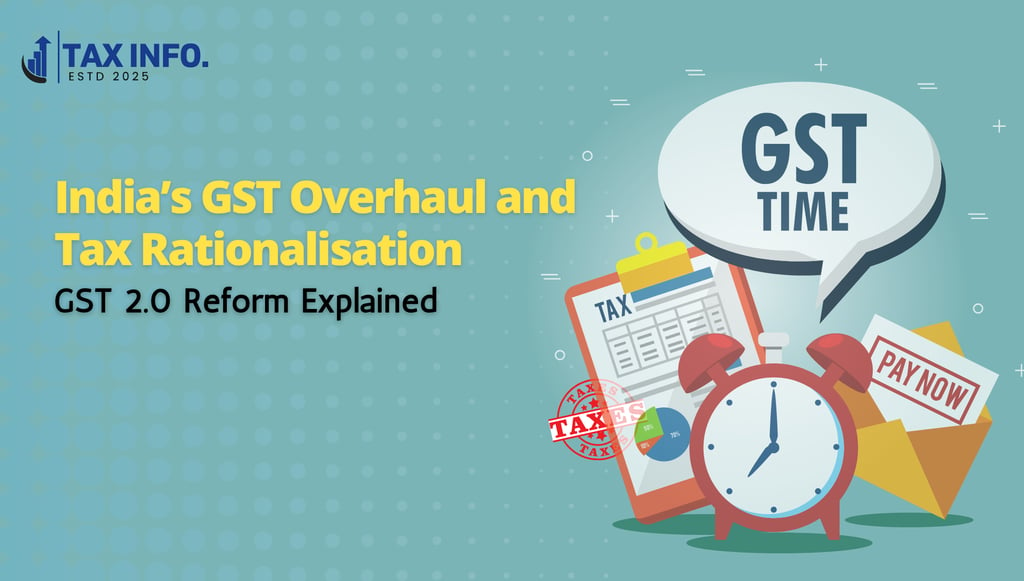
India’s GST Overhaul and Tax Rationalisation - GST 2.0 Reform Explained
Tax Info Online


Why GST 2.0 Was Needed
1. Complex Rate Structure
Currently, GST has four main slabs: 5%, 12%, 18%, and 28%. In practice, the overlapping categories have led to confusion and litigation. GST 2.0 intends to consolidate slabs into three tiers for clarity.
2. Inverted Duty Structures
In many industries, inputs are taxed at higher rates than finished goods. For example, footwear manufacturers pay more tax on raw materials than on shoes, leading to working capital blockages. The new system aims to correct such anomalies.
3. High Litigation and Classification Issues
Businesses often face disputes on whether a product falls under 12% or 18% GST, leading to tax uncertainties. GST 2.0 will create a central classification authority to ensure uniformity.
4. Need for Digital-First Taxation
With India’s digital economy booming, GST filing needs AI-driven compliance tools, automation, and simplified return mechanisms.
Key Features of India’s GST Overhaul and Tax Rationalisation
1. Rationalised GST Slabs
Simplified structure with three tiers instead of four.
Essentials may fall under lower tax slabs, while luxury and sin goods will attract higher levies.
2. Correction of Duty Inversion
Adjustments in raw material taxation.
Relief for sectors like footwear, textiles, and pharma.
3. Stronger Compliance Through Technology
Expanded use of AI, blockchain, and real-time data matching.
Faster refunds and reduced fraudulent claims.
4. Dispute Resolution Mechanism
Setting up of a central dispute authority.
Reduction in court cases and greater tax certainty.
5. Special Levy on Sin Goods
Additional cess on tobacco, alcohol, aerated drinks, and luxury cars.
Proceeds will support state revenues and public health initiatives.
Impact of GST 2.0 Reform
For Businesses
Lower compliance costs due to streamlined returns.
Improved cash flows with faster refunds.
Level playing field across industries.
For Consumers
Lower prices for essential goods and services.
More transparent tax incidence.
Better availability of products with reduced litigation delays.
For Government
Wider tax base and stronger revenues.
Increased compliance with digital monitoring.
Ability to fund infrastructure and welfare schemes effectively.
Benefits of Tax Rationalisation in India
Economic Growth Boost – A simpler GST structure encourages investments.
Ease of Doing Business – Reduced paperwork and faster dispute resolution.
Fair Taxation – Essential goods taxed lower, luxury items higher.
Increased Exports – Duty inversion corrections make Indian goods more competitive globally.
Revenue Stability – Sin goods levy ensures state revenues don’t fall.
Challenges in Implementing GST 2.0
Balancing Revenue vs. Lower Rates: States fear revenue loss with fewer slabs.
Transition Pains: Businesses will need time to adjust ERP systems, invoices, and filings.
Political Consensus: GST decisions require GST Council approval, where states may resist.
Compliance Burden During Transition: Dual systems may briefly exist.
Comparison: GST 1.0 vs GST 2.0
Feature GST 1.0 (2017)GST 2.0 (Upcoming)Tax Slabs 4 slabs (5, 12, 18, 28%)Likely 3 slabs Duty Inversion Present in many sectors To be corrected Compliance Complex, multiple returns AI-driven, simplified Dispute Resolution Court-based Central Authority Sin Goods Tax Limited cess Expanded cess structure Digital Integration Basic GSTNAI, Blockchain, Automation
Global Lessons for India’s GST Reform
Australia: Adopted a single slab GST, reducing disputes.
Canada: Uses federal + provincial GST model, balancing autonomy and centralisation.
Singapore: Low GST rate (9%) but broad tax base, ensuring simplicity.
India’s GST 2.0 blends global best practices with local economic realities.
Future of GST in India
GST 2.0 is not the end—future reforms may include:
Unified national digital tax system.
Further rate simplification to 1–2 slabs.
Integration with direct tax reforms for a holistic system.
Frequently Asked Questions (FAQ)
1. What is GST 2.0 in India?
GST 2.0 refers to the new wave of reforms in India’s Goods and Services Tax, focusing on simplification, rationalisation, and technology-driven compliance.
2. How will GST rationalisation affect businesses?
Businesses will benefit from lower compliance costs, faster refunds, and reduced litigation due to clearer classification rules.
3. What are sin goods under GST?
Sin goods include tobacco, alcohol, luxury cars, and aerated drinks—products taxed higher due to negative health or social impacts.
4. Will GST 2.0 lower tax rates?
Yes, essential goods may see reduced tax rates, but luxury and sin goods will face higher levies to balance revenue.
5. When will GST 2.0 be implemented?
The exact timeline depends on GST Council approval, but phased implementation is expected from 2025 onwards.
Conclusion: A Milestone in India’s Tax Evolution
The India GST Overhaul and Tax Rationalisation is a bold reform that can reshape the tax landscape for decades to come. By simplifying structures, correcting anomalies, and embracing technology, GST 2.0 ensures fairness, transparency, and growth.
If implemented effectively, it could serve as a global model for next-generation taxation, ensuring India’s economic journey remains strong, competitive, and inclusive.
Introduction: The Dawn of GST 2.0
Since its rollout in 2017, the Goods and Services Tax (GST) has been a landmark tax reform in India, replacing multiple state and central levies with a unified indirect tax system. While GST simplified many aspects of taxation, loopholes and structural issues soon surfaced. Businesses struggled with classification disputes, inverted duty structures, and cumbersome compliance requirements.
To address these, India is introducing a comprehensive GST Overhaul and Tax Rationalisation, popularly called GST 2.0. This reform is designed to simplify tax rates, resolve duty mismatches, enhance compliance, and strengthen revenue generation, making India’s tax regime more predictable and growth-oriented.
